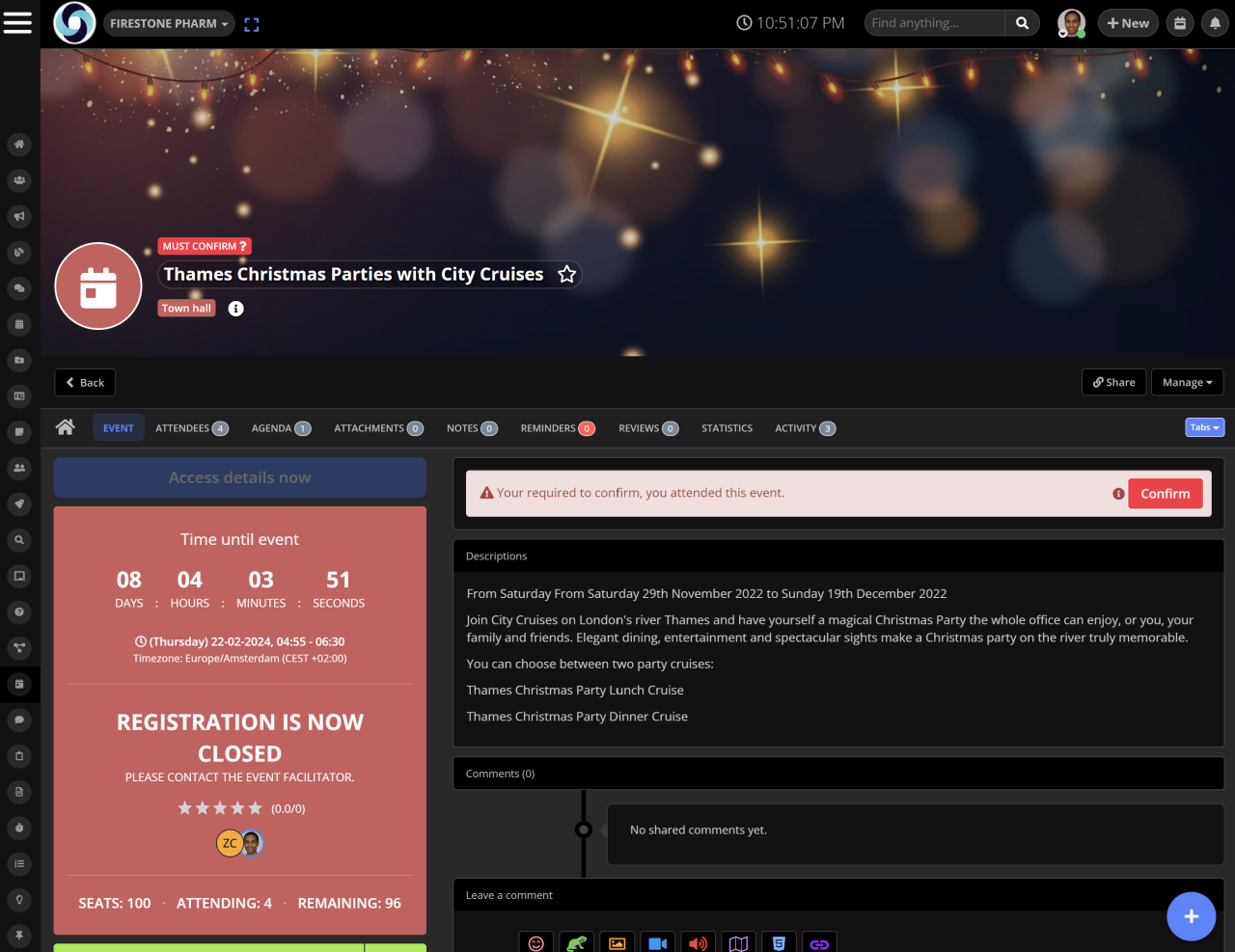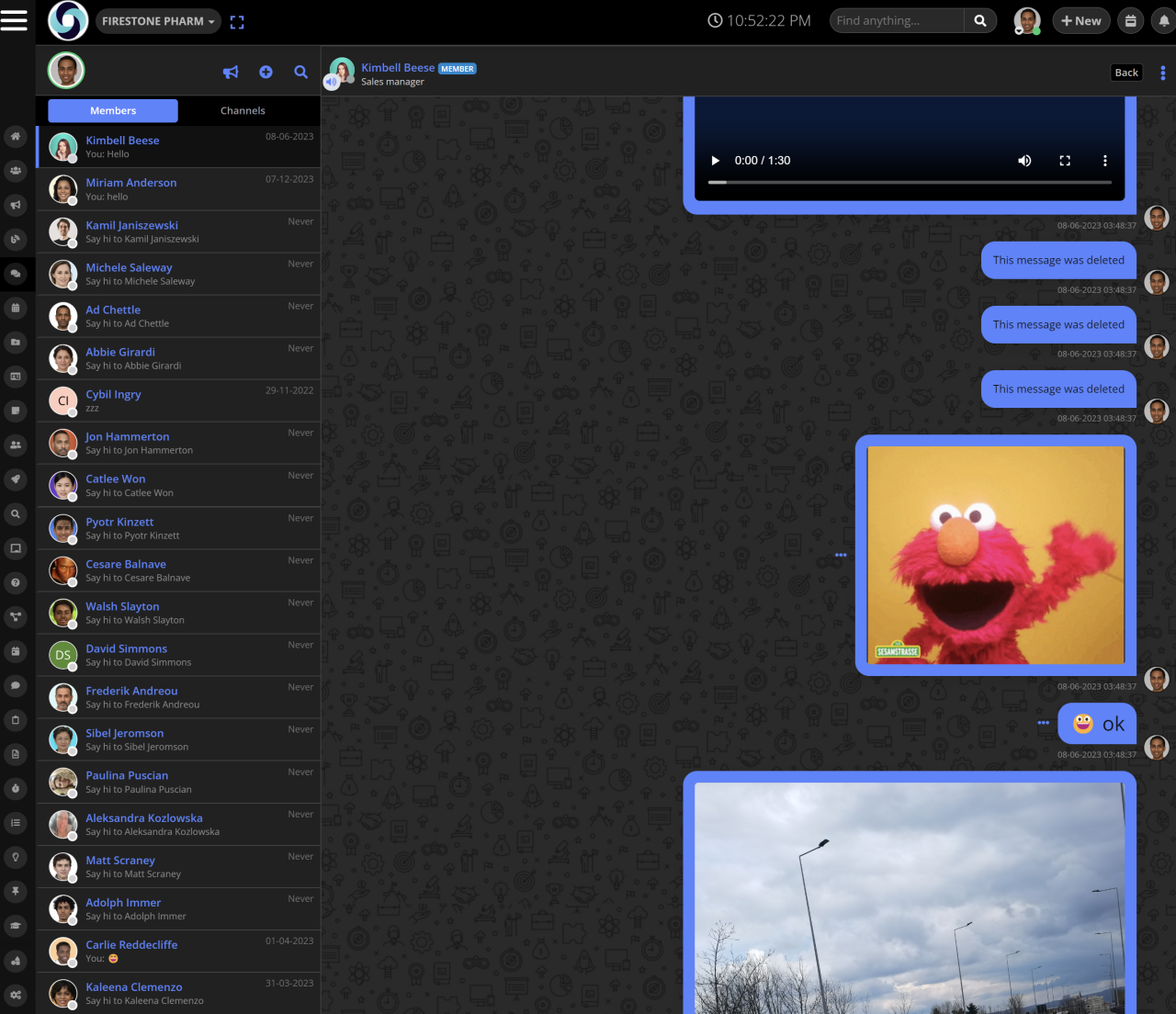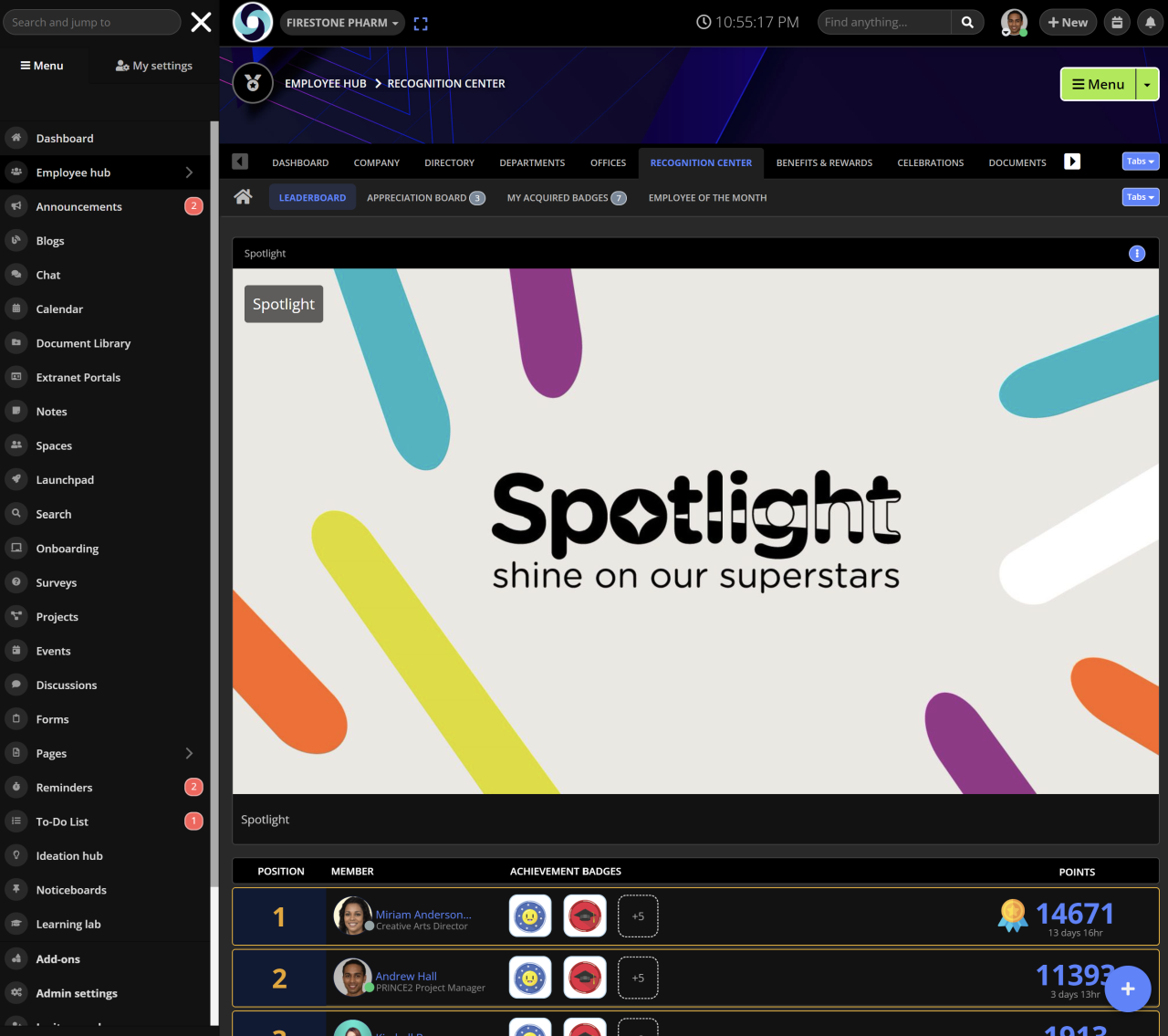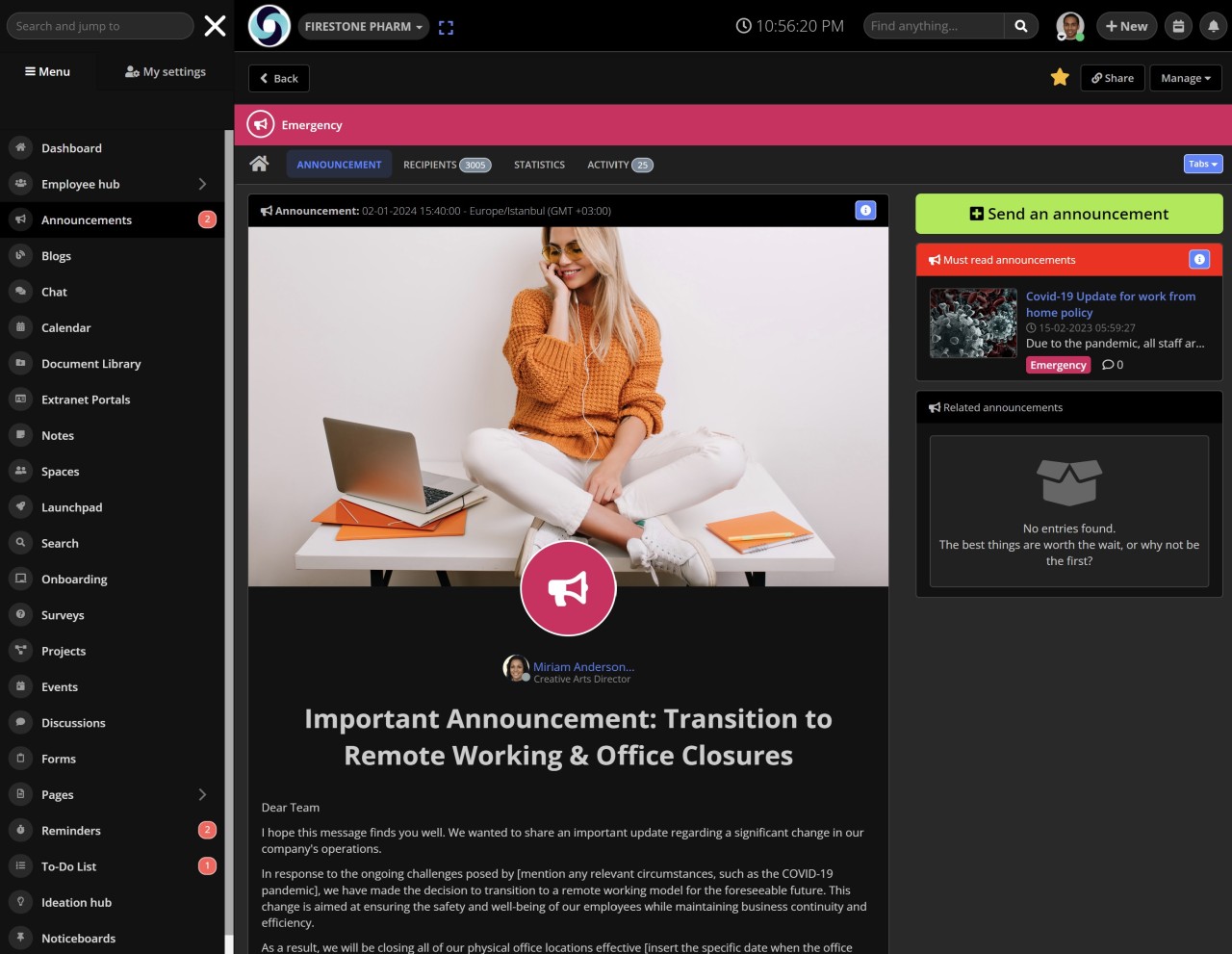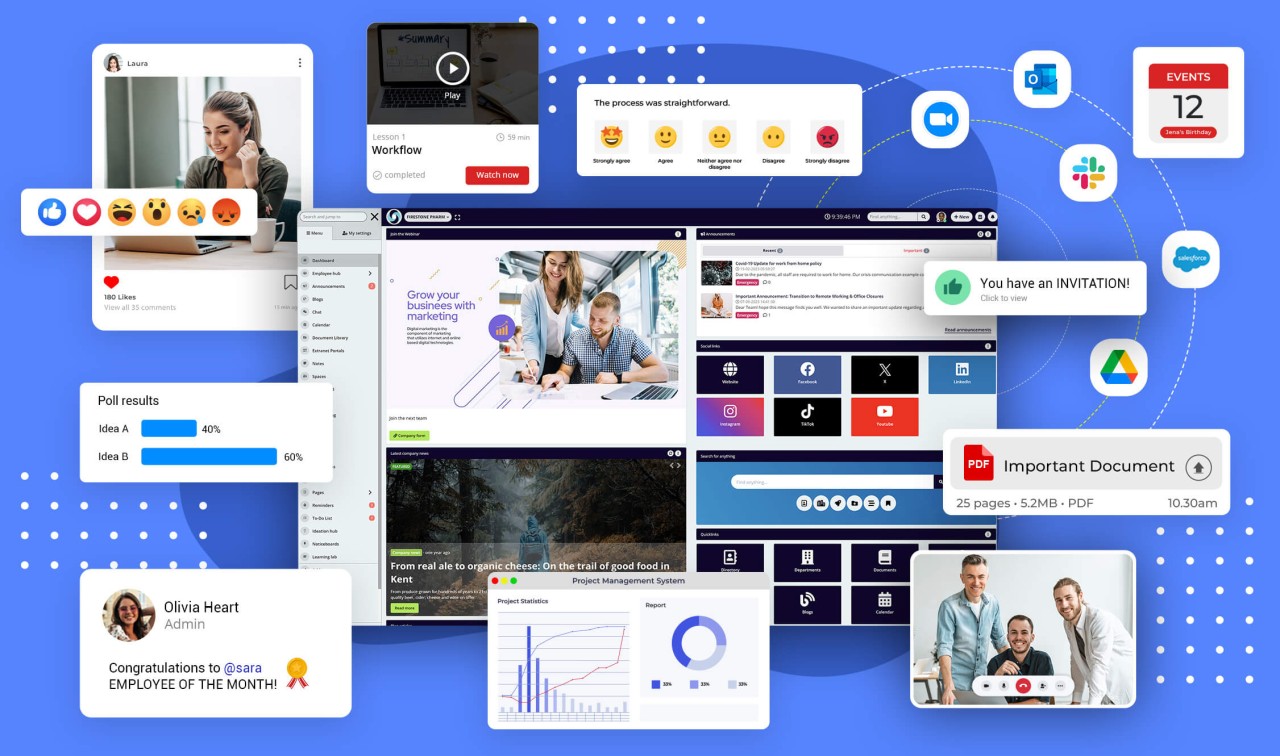Insight Blog
Agility’s perspectives on transforming the employee's experience throughout remote transformation using connected enterprise tools.
22 minutes reading time
(4423 words)
10 Best Communication Tools Every Business Needs in 2026
How can communication tools Boost productivity, increase engagement and improve communication across your organization with these tools.
According to Gallagher's recent report, teams are increasingly seeking a more streamlined communication tools, recognizing the impact of scattered communication tools on their daily work and productivity.
This has prompted 55% of companies to invest strategically in enhancing internal communication. Additionally, thanks to the lingering presence of the Omicron variant, return-to-office plans are on an indefinite hiatus, making the prospect of in-person collaboration with colleagues seem distant.
The reluctance to embrace full-time office work is evident in the sentiments of 97% of employees, with 61% expressing a clear preference for complete remote work.
The reluctance to embrace full-time office work is evident in the sentiments of 97% of employees, with 61% expressing a clear preference for complete remote work.
Given this paradigm shift in workplace preferences, companies must reevaluate the communication tools central to their operations, with a specific focus on the AgilityPortal.
In the traditional office environment, camaraderie often flourished through face-to-face meetings and casual interactions.
In the traditional office environment, camaraderie often flourished through face-to-face meetings and casual interactions.
However, adapting to the dynamics of remote work calls for a fresh perspective. It is crucial to rethink the composition of your communication toolkit for a dispersed workforce, considering how it can enhance both productivity and morale within the organization.
In the upcoming sections, we will explore the details of the 10 most effective tools.
Before delving into these specifics on company communication tools, let's underscore the importance of carefully selecting the appropriate communication tools for your business, emphasizing the role of the AgilityPortal in this context.
What is Team Collaboration?
Team collaboration occurs when employees work together harmoniously toward shared business objectives. Instead of focusing solely on individual goals, the team prioritizes what is best for the company. An exemplary instance of team collaboration arises when teams collaborate on a shared project, yielding tangible benefits for the business.
Essential for its inclusion of diverse skills, team collaboration is pivotal for the company's success. It necessitates collective efforts in projects and processes aligned with the overarching business strategy. Encouraging the sharing of ideas and fostering creativity drives innovation to address new challenges.
It is imperative to motivate employees to transcend personal accomplishments and rally around a common mission. Team collaboration encompasses a blend of culture, processes, and technology, fostering an environment conducive to collective effort.
What are the importance of communication tools
A communication tool encompasses a wide range of applications, software, or online platforms designed to facilitate collaboration and communication among dispersed and remote teams, regardless of their locations.
Recognizing the paramount importance of effective communication in business, PMI's Pulse of the Profession report emphasizes that workplace communication significantly influences the success or failure of a project. Shockingly, one out of every five projects fails due to inadequate communication, whether it be among team members or project managers.
Failure to provide your team with appropriate workplace communication tools is akin to furnishing them with a typewriter in a world where competitors have iMacs—rendering them unable to compete effectively.
Workplace collaboration tools extend beyond mere greetings; they can function as group messaging platforms disseminating broadcast messages to entire teams, project management tools overseeing tasks and progress, or analytics applications monitoring staff morale.
Given the extensive coverage of team communication tools, the multitude of options available can be overwhelming. So, what criteria must a communication tool meet to earn a spot on our list?
Now that we have understood the importance of communication tools, lets get into the Efficient Communication Tools and the several key characteristics.
Attributes of Efficient Communication Tools
Effective company communication tools share several key characteristics.
They not only enhance internal team communication within a business but also streamline workflow, making task completion more efficient.
The top-notch team communication tools serve a dual purpose as productivity tools by facilitating quick information sharing and automating repetitive tasks, ultimately giving your team more time for their core responsibilities.
An often overlooked yet crucial characteristic of an effective communication tool is adoption. A successful communication tool seamlessly integrates with your existing tech stack, and it's advisable to invest in tools with minimal learning curves.Given the challenges your team already faces, introducing complex software can be counterproductive. Instead, opt for tools that align with your team's existing comfort level, such as social intranets and messaging apps resembling the software they use outside of work.
The simplicity of your internal corporate communication tools directly influences their usage, so choosing user-friendly options increases the likelihood of effective implementation.
Distinguishing Communication Tools for Small Businesses and Enterprises
Communication dynamics in business are shaped by the size of the enterprise, and it's important to recognize that not all communication tools are universally applicable.
The technological infrastructure, or tech stack, employed by a small business with a team of 10 will differ from that of an enterprise boasting 5000 employees.
A case in point is AdRoll, an SMB with around 100 employees, which organizes its tech stack into categories such as internal communication, customer feedback, customer communication, and customer support.
While smaller companies may not require the full spectrum of tools deployed by AdRoll, versatile software like Slack or Intercom can still prove transformative in fostering communication among team members and engaging with customers.
The key lies in identifying the tools that align best with your company's specific needs. In the following sections, we will delve into our top 10 recommendations, considering the diverse requirements of businesses in various sizes.
Follow us and access great exclusive content everyday: Follow us on Google News
Benefits of Using Workplace Communication Tools and Software
Significant portions of business expenditures are typically allocated to property-related expenses, such as rent and taxes.
The pandemic, with its widespread adoption of remote work, has led to a reduction in these costs and a strategic realignment of budgets towards more value-adding investments, particularly in internal communication tools.
If you're contemplating investments in communication and employee engagement tools, you're making a prudent decision.
Beyond facilitating connectivity for hybrid and remote teams, modern business communication tools offer a range of benefits that positively impact the entire organization.
Here are some key advantages of implementing these contemporary tools:
Communication Tools can Improve collaboration, heightened productivity, and increased employee engagement.
Leaders often encounter challenges in fostering employee engagement, considering it a formidable task in organizational maintenance. The extent of employee productivity is significantly influenced by their sense of value and involvement.
Therefore, highly effective managers prioritize ensuring continuous engagement and keeping their teams well-informed.
Centralizing employee communication is crucial for maintaining peak levels of engagement and productivity within any organization.By leveraging internal communication tools, organizations provide a platform that enables employees to consistently align, promoting productivity, effectiveness, and efficiency even in remote work scenarios.
Communication Tools can Secure business communication
An increasing number of companies are increasingly dependent on technology, a trend driven by compelling reasons.
However, while embracing these technological applications, companies must exercise diligence to prevent data loss or breaches.
Prioritizing data security should stand out as one of an organization's foremost investments, aiming to steer clear of legal consequences and potential ramifications.
In light of this, selecting the right team communication tools is critical for businesses. With the appropriate internal communication tools featuring end-to-end security, organizations can enhance the protection of business communication and safeguard sensitive data effectively.Communication Tools can Streamline communication under one roof
Implementing a knowledge center tool or platform plays a pivotal role in empowering managers and team leaders to streamline their oversight of work progress, employee communication objectives, and project assignments.
By embracing these tools, organizations can elevate their ability to maintain clarity and coherence in their operations.
In the complex landscape of modern workplaces, characterized by information overload, the risk of losing critical data, details, and task-related information is imminent.
This is where team communication tools step in as invaluable assets, serving as a centralized hub that consolidates all essential information pertaining to assignments.
This consolidated approach not only mitigates the risk of information getting lost but also enhances accessibility, providing stakeholders with a holistic and real-time overview of the status and requirements associated with each task.
This, in turn, facilitates informed decision-making, efficient collaboration, and a more streamlined workflow throughout the organization.
You may also like: Best Apps for Employees: UPDATED 2022 – A Complete Guide
What types of internal communication tools are there?
Internal communication serves as the vital link between organizations and their employees, fostering awareness, disseminating information, cultivating involvement, motivating individuals, and facilitating cooperation in decision-making processes.
Based on its diverse purposes, internal communication can be categorized into various types:
- Task Information: Purpose: To inform employees about their roles and responsibilities. Content: Provides clear job descriptions and instructions to guide individuals in their tasks, perfect for communication tools for project management adn task management.
- Management Information: Purpose: Ensures that activities are executed by the right individuals at the appropriate time.Content: Includes schedules and organizational plans to coordinate tasks effectively.
- Commercial Information: Purpose: Essential for customer-facing employees, offering detailed insights into products, prices, and services.Content: Encompasses information crucial for interactions with customers, enhancing service delivery.
- Policy Information: Purpose: Ensures that every employee is well-informed about organizational and legal procedures.Content: Communicates policies and procedures to maintain consistency and compliance.
- HR Information: Purpose: Primarily deals with administrative affairs and supports services.Content: Covers information related to HR policies, benefits, and administrative procedures.
- Motivational Information: Purpose: Cultivates a motivating environment where employees are inspired to enhance both personal growth and organizational success. Content: Includes information on social issues, prospects, and initiatives that encourage employee engagement and commitment.
By understanding and effectively utilizing these different types of internal communication, organizations can create a cohesive and informed workforce, fostering a positive and productive work environment.
10 Best Workplace Communication Tools for Teams in 2024
In the realm of company communication tools, these platforms have evolved to incorporate functionalities such as task management, instant messaging, document collaboration, virtual meetings, group chat, and video calls.
The challenge lies in selecting the most suitable option for your needs. To assist you in this decision-making process, here is a compilation of the communication tools, communication tools example and the top 10 internal communication tools.
This roundup includes insights into their standout features, limitations, pricing details, and reviews, providing you with the necessary information to make informed choices for your team and organization.
1. Emails
Despite persistent assertions that email communication is losing prominence, it remains a pivotal communication channel in the majority of organizations due to its simplicity and widespread accessibility.
Emails serve as an effective means to communicate updates, news, schedules, or relevant links to the entire staff or convey personalized messages.
However, it is essential to acknowledge certain drawbacks associated with this communication method:
- Information Overload: Frontline employees may not have dedicated work email addresses, increasing the likelihood of emails getting lost, accidentally deleted, or forgotten.
- Length Concerns: Younger generations, characterized by shorter attention spans, may find lengthy emails challenging to engage with, leading to potential information loss.
- Limited Feedback Facilitation: Email communication often falls short in encouraging and facilitating timely feedback, hindering effective collaboration.
- Media Support Limitations: Email platforms may not seamlessly support various types of media, restricting the versatility of content that can be shared.
- Limited Shareability and Engagement: Emails may lack the shareable and engaging attributes required for effective communication, particularly in environments where quick sharing and interaction are essential.
While email remains a valuable tool for organizational communication, it is imperative to recognize these limitations and explore alternative methods that better align with the evolving preferences and communication styles of today's workforce. Some alternatives may include asynchronous communication software for business. Use it if you want to establish flexible communication with your teams and clients.
2. Instant messaging
WhatsApp and Messenger group chats stand out as widely utilized internal communication tools in the workplace due to their mobile-centric nature, enabling users to seamlessly share messages, photos, GIFs, files, and videos.
An added advantage lies in the widespread adoption of these apps, as most employees already have them installed on their phones. However, despite the apparent convenience, challenges emerge upon closer inspection.
While these platforms may initially appear as the easiest and quickest way to connect with young frontline employees, practical issues surface. Managers often find managing group chats time-consuming, and employees can feel disrupted when added to group conversations involving potentially hundreds of participants.
This disruption leads to a tendency to ignore messages, resulting in important information failing to reach the intended recipients in a timely manner.
Moreover, the use of platforms like WhatsApp for internal communication raises significant privacy concerns.
The practice involves sharing all contact information with participants without explicit permission, breaching privacy boundaries and potentially causing discomfort among employees.
Considering these challenges, organizations should carefully weigh the pros and cons of using such mobile-based communication tools and explore alternative solutions that address both efficiency and privacy concerns.
3.All-in-one employee apps can be used as a company communication tool
Employee experience encompasses every aspect of what an individual perceives, feels, and engages in within their job role, covering all touchpoints throughout their journey in the organization.
This holistic perspective involves factors such as the onboarding process, training initiatives, workplace culture, company surveys, rosters, and interactions with colleagues.
While internal communication is a crucial element, it represents just one facet of the broader communication collaboration tools.
The introduction of an all-in-one employee app can yield numerous benefits for organizations, playing a pivotal role in enhancing:
- Workplace Productivity: Streamlining information access and communication through an employee app can significantly contribute to heightened workplace productivity.
- Customer Service Levels and Satisfaction: Improved communication and information accessibility for frontline employees translate to enhanced customer service, directly impacting customer satisfaction levels.
- Employee Engagement: An employee app serves as a platform for fostering engagement by providing valuable information, creating a sense of connection, and facilitating efficient communication.
- Employee Loyalty: By offering convenient access to information, support, a digital learning environment, and HR tools, employee apps contribute to building a sense of loyalty among employees.
The introduction of these apps is particularly beneficial for the younger generation of employees, as it aligns with their preference for accessibility and efficiency in digital solutions.
These platforms empower frontline employees by placing a wealth of helpful resources directly at their fingertips, ultimately contributing to a positive and streamlined employee experience. You can create a corporate communications center in your organisation using an employee app.
4. Internal Communication Platforms
Internal communication platforms serve as effective and secure solutions for engaging employees through their personal devices, presenting a diverse range of both desktop and mobile options that cater to varied organizational needs.
The ease of implementation further contributes to the popularity of these platforms in the market.
Key benefits associated with the utilization of internal communication platforms include:
- Connecting with Remote Employees: Facilitating communication with employees lacking corporate email addresses or access to computers, particularly those working remotely.
- Cultivating Company Culture Across Locations: Strengthening and disseminating the company culture seamlessly across multiple locations, ensuring a cohesive organizational identity.
- Enhancing Efficiency and Productivity: Enabling targeted communication by delivering pertinent information to the right individuals at the right time, thereby boosting overall efficiency and productivity.
- Promoting Collaboration: Fostering communication among employees encourages active support and collaboration, leading to increased teamwork and cooperation.
- Employee Engagement: Engaging employees by providing a platform to share ideas, achievements, and successes, fostering a sense of community and celebration within the organization.
- Talent Attraction and Retention: Playing a crucial role in attracting and retaining talent by reinforcing a strong company culture and empowering employees to become brand ambassadors through an active and clear communication strategy.
However, it's essential to note that while these platforms offer valuable benefits for internal communication, many are confined to this specific function.
Organizations may still need to integrate additional tools and software to provide a fully comprehensive employee experience.
As the market continues to evolve, organizations should carefully consider their specific needs and objectives when selecting and implementing internal communication solutions.
5. Social media
Social media platforms, including LinkedIn, Facebook, Twitter, Google+, Instagram, and YouTube, offer a multitude of advantages such as networking, project collaboration, and information sharing.
These platforms allow users to share diverse forms of media, engage through likes, comments, and resharing, creating opportunities for multi-directional communication when employed for internal communications.
However, it's important to note that social media platforms were not originally designed for internal communication purposes. Despite their adaptability, employees typically prefer utilizing social media for personal rather than professional interactions, introducing potential privacy concerns.
Employees are often required to use their personal accounts, where they may not wish to be contacted, and these accounts may contain information they prefer not to share with work colleagues.
Balancing the convenience and functionality of social media for internal communication with the privacy and personal preferences of employees poses a challenge.
Organizations need to carefully navigate these considerations when utilizing social media platforms for internal communications to ensure effective communication while respecting individual boundaries and privacy concerns.
6.Intranet
An intranet serves as an organization's internal network, providing a centralized platform for gathering and disseminating a wealth of information and training courses accessible to all company members. However, the traditional intranet, once considered cutting-edge, has become outdated in the face of evolving work dynamics.
The landscape of work has undergone significant transformations in recent years, rendering traditional intranets less effective.
These platforms often lack integration possibilities, compelling employees to navigate multiple systems with separate logins. Moreover, their capabilities for sharing interactive and media-rich content are limited, and they are ill-equipped to facilitate seamless two-way communication.
As the modern workplace continues to evolve, traditional intranets find themselves struggling to adapt to the demands of the mobile age and the preferences of the younger generation of employees.
Recognizing these limitations, organizations are seeking innovative solutions that align with the contemporary work environment, emphasizing integration, interactive content sharing, and effective two-way communication to meet the diverse needs of today's workforce.
7. Team meetings
Daily stand-ups, briefings, and regular face-to-face meetings undeniably contribute value to the daily operational dynamics and prove to be advantageous for fostering employee engagement.
Supervisors and managers take the lead during these interactions, providing a platform for immediate responses from employees, allowing them to pose questions or raise concerns promptly.
Yet, a significant challenge surfaces when it comes to frontline employees operating on diverse shift patterns. Time constraints hinder managers from effectively briefing and disseminating information every time a new shift commences.
This time crunch often results in a cursory level of attention, leading to persistent misunderstandings that, in turn, compel managers to repeat information incessantly.
Moreover, relying solely on these traditional communication methods severs the vital connection between frontline employees and headquarters. This detachment manifests in diminished engagement and retention rates, creating a noticeable gap between employees and the organizational core.
Addressing these challenges necessitates exploring alternative communication strategies tailored to the specific needs of diverse work schedules. Such an alternative can be the use of a background noise removal app as it emerges as a key solution, ensuring seamless virtual communication despite the varying shifts of employees.
Such strategies should aim to foster a deeper understanding among employees while establishing a robust and enduring connection between frontline workers and the central hub of the organization.
8. Chat messaging
Internal communication transcends mere top-down messaging orchestrated by the HR team. To truly empower and engage your employees, fostering collaboration becomes paramount.
This becomes especially valuable in cross-functional settings—understanding Engineer–PM Collaboration can highlight just how important seamless communication tools are for successful collaboration.
By integrating a chat feature, you provide a dynamic platform for real-time communication and collaboration.
This facilitates seamless interaction among team members, promoting the exchange of ideas, information, and feedback. Moreover, the chat functionality cultivates a sense of camaraderie and connection among employees, enhancing overall engagement.
The benefits extend beyond conventional communication methods, as employees can effortlessly collaborate on projects, share insights, and coordinate tasks in an efficient and instantaneous manner.
Embracing such interactive tools not only strengthens teamwork but also contributes to a vibrant and interconnected workplace culture, ultimately enhancing the success and engagement of your employees.
9. Recognition and reward programs
Recognize and applaud exceptional performances, acknowledging individuals who consistently go above and beyond to satisfy customers or demonstrate outstanding teamwork.
Studies reveal that 88% of employees highly value recognition from their peers, and there's a well-established connection between celebrating success and elevated levels of employee motivation.
By actively celebrating achievements, whether they be exceptional customer service or exemplary team collaboration, organizations foster a positive and motivating work environment.Recognizing outstanding efforts not only boosts the morale of the individuals being honored but also inspires a sense of pride and camaraderie among the entire workforce.
It's essential to incorporate regular recognition practices into the workplace culture, as this not only reinforces positive behavior but also serves as a powerful motivational tool.
It's essential to incorporate regular recognition practices into the workplace culture, as this not only reinforces positive behavior but also serves as a powerful motivational tool.
This deliberate acknowledgment of exceptional contributions contributes to a motivated and engaged workforce, enhancing overall team dynamics and organizational success.
10. Internal newsletters
The traditional newsletter remains a valuable communication tool, particularly for organizations with desk employees who readily access company emails. It serves as a popular means of engaging with this demographic.
However, for organizations predominantly comprised of frontline workers, the effectiveness of newsletters may dwindle, often left unread. To address this, consider adopting contemporary, mobile-friendly methods for sharing crucial monthly business updates, highlighting employee or team of the month awards, and promoting upcoming campaigns.
In the era of mobile technology, optimizing communication channels for accessibility and convenience is essential.Explore innovative ways to deliver information, ensuring that it resonates with all employees, including those on the frontline. Utilizing mobile-friendly platforms, such as dedicated apps or interactive communication tools, can enhance engagement and ensure that vital updates reach the entire workforce.
This approach not only aligns with modern communication trends but also contributes to fostering a more connected and informed organizational culture.
Free ebook: How To Get Your Intranet Off The Ground
What Makes a Good Workplace Communication Software?
When seeking out communication tools, the objective should revolve around identifying solutions that align with your evolving requirements, providing flexibility, security, and cost-effectiveness.
Embracing technological innovation often entails significant expenses.
Embracing technological innovation often entails significant expenses.
Managers face the challenge of finding the equilibrium between costs and benefits, conducting a meticulous assessment of the return on investment for substantial interventions that impact significant facets of company operations.
Here are crucial considerations to bear in mind during your quest for internal communication tools:
Here are crucial considerations to bear in mind during your quest for internal communication tools:
- Collaboration Features: Efficient collaboration is the cornerstone of successful teamwork. Look for tools that facilitate real-time collaboration on documents, projects, and tasks. Features such as simultaneous editing, version control, and comment threads can enhance the collaborative process, fostering seamless and productive teamwork.
- App Integrations: A robust internal communication tool should seamlessly integrate with other essential applications your team relies on daily. The ability to connect with project management tools, calendars, and customer relationship management (CRM) systems enhances efficiency by consolidating information and workflows into a centralized hub.
- Project and Task Management: A comprehensive communication tool should incorporate project and task management capabilities. This enables teams to plan, assign, and track tasks within the same platform used for communication. This integration ensures that discussions align directly with ongoing projects, promoting clarity and accountability.
- Voice and Video Conferencing: In the era of remote and dispersed teams, effective communication often demands more than text. Look for tools that offer reliable voice and video conferencing features. Seamless virtual meetings, with options for screen sharing and recording, are essential for maintaining a sense of connection and collaboration among team members.
- Direct and Group Messaging: Clear and instant communication is vital for swift decision-making. Ensure your chosen tool supports both direct messaging for one-on-one conversations and group messaging for broader team discussions. Features like notifications and threaded conversations can contribute to organized and efficient communication.
- File Sharing: Streamlining document sharing is crucial for collaborative projects. A robust communication tool should provide a secure and user-friendly environment for sharing files. Features like version control, access permissions, and file organization contribute to a smooth file-sharing experience.
- Team Mailing List: Effective communication within larger teams often involves disseminating information to specific groups. A team mailing list feature allows for targeted communication, ensuring that relevant updates and announcements reach the intended audience without overwhelming the entire team.
- Encryption and Security Features: With the increasing threat of cyber incidents, prioritizing the security of sensitive information is paramount. Opt for communication tools that employ robust encryption methods and stringent security measures. Features like two-factor authentication and data encryption at rest and in transit enhance the overall security posture of the tool.
Given the escalating frequency of data breaches and cyber incidents in recent years, organizations must prioritize the use of apps and programs that prioritize cybersecurity. This precautionary measure is crucial to avoid compromising sensitive data and information.
Keep Your Remote Teams Productive and Connected with AgilityPortal
Regardless of the specific features, benefits, or budget considerations you have in mind when selecting workplace communication software, a meticulous evaluation of your organization's needs and, crucially, your employees' requirements is essential.
The optimal internal communication software should adeptly support remote work and facilitate asynchronous communication, knowledge-sharing, and collaboration. These functionalities should seamlessly span from top management down to the staff level, ensuring a cohesive and interconnected communication infrastructure.
Consider all-in-one productivity tools like AgilityPortal, an exceptional project management and communication solution designed for the entire organization.
This comprehensive platform is equipped with a myriad of features, fostering collaboration and communication to meet the diverse needs of your teams.
From facilitating group discussions to monitoring project workflows and enabling real-time collaboration on plans and projects, AgilityPortal aims to enhance communication across all levels, regardless of geographical locations.
AgilityPortal offers a risk-free trial, allowing you to seamlessly connect your distributed teams, elevate cross-functional communication, and consolidate all your work in a unified platform.
Take the step to bring your teams together and enhance collaboration – try our corporate communications tool AgilityPortal for free today!
Categories
Blog
(2664)
Business Management
(326)
Employee Engagement
(213)
Digital Transformation
(178)
Growth
(122)
Intranets
(120)
Remote Work
(61)
Sales
(48)
Collaboration
(39)
Culture
(29)
Project management
(29)
Customer Experience
(26)
Knowledge Management
(21)
Leadership
(20)
Comparisons
(7)
News
(1)
Ready to learn more? 👍
One platform to optimize, manage and track all of your teams. Your new digital workplace is a click away. 🚀
Free for 14 days, no credit card required.







